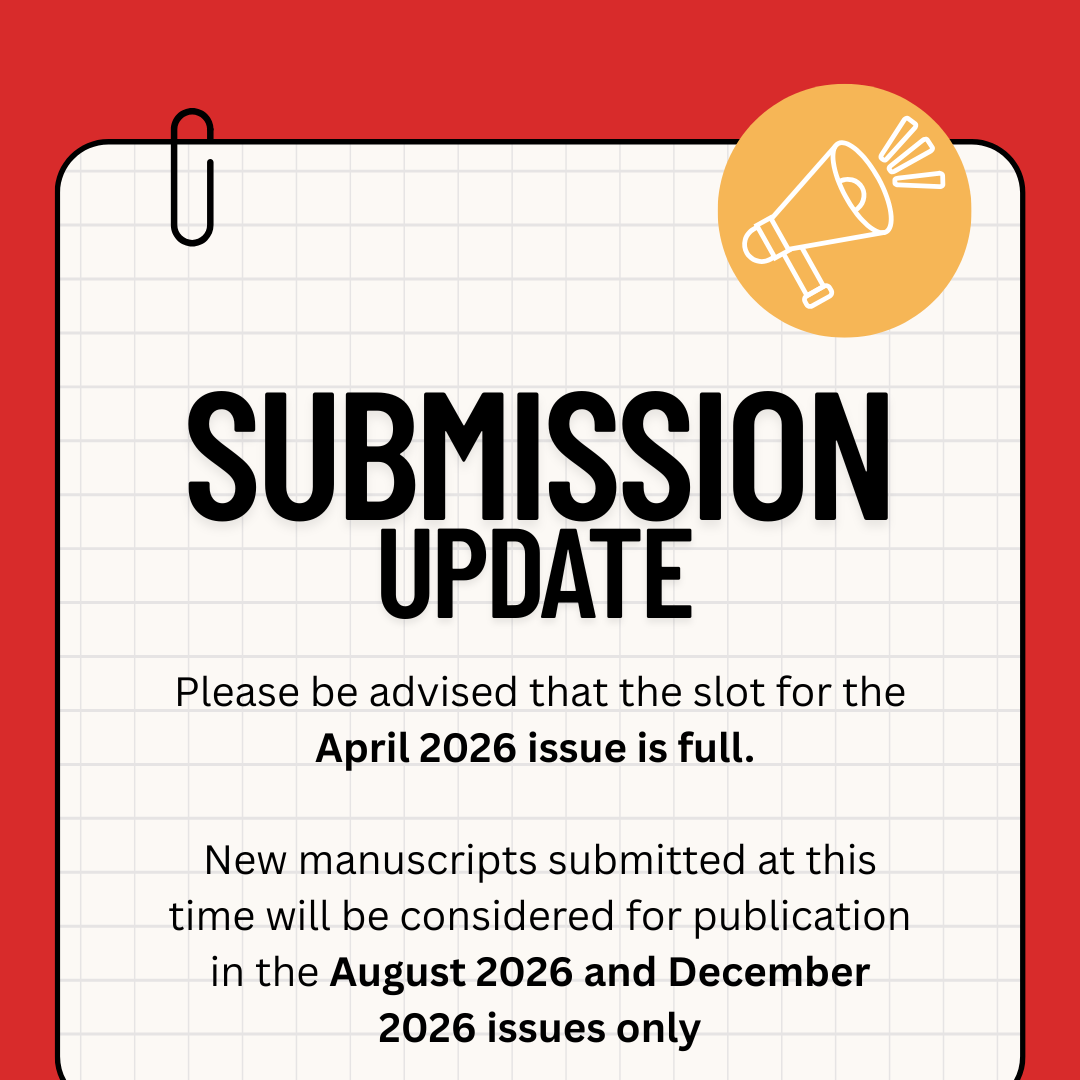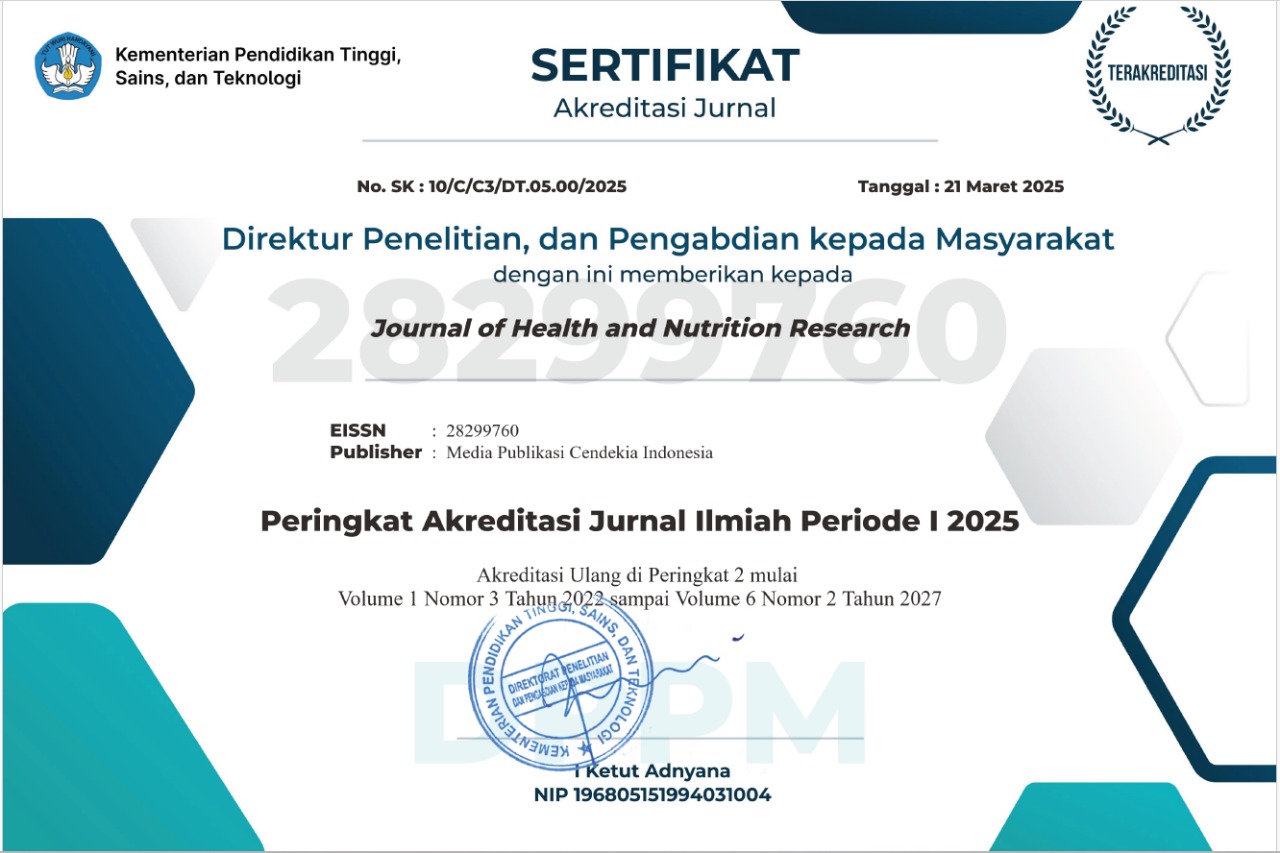The Effect of SEKAR (Sumber Edukasi Anemia yang Relevan) Card-Based Nutrition Education on Knowledge and Iron Intake in Pregnant Women
Keywords:
SAER, Pregnant, Knowledge, Iron Intake, AnemiaAbstract
Anemia in pregnant women is one of the most common public health emergencies, especially in low- and middle-income countries, such as Indonesia. This study aims to determine the effect of SEKAR (Sumber Edukasi Anemia yang Relevan) card-based nutrition education on knowledge and iron intake in pregnant women at the Mangkupalas Samarinda Health Center. The type of research used is an experimental study with a pre-test and post-test research design with the control group. A total of 36 pregnant women were taken into samples divided into 2 groups, namely 18 interventions and 18 controls based on inclusion and exclusion criteria. Nutrition education variables were obtained using SEKAR cards and leaflets containing information about anemia. The knowledge was obtained using a structured questionnaire that had been validated and a pregnant woman's iron intake was obtained using a 24-hour in-depth food recall interview. Data were analyzed using the Wilcoxon and Mann-Whitney tests. Results show that the effect of nutrition education using SEKAR on the knowledge of pregnant women (p = 0.003), and iron intake (p = 0.031). Leaflet media did not affect knowledge (p = 0.072) and iron intake (p = 0.078). There was a significant difference between SEKAR cards and leaflets on knowledge improvement (p = 0.001) and there was no significant difference between the use of SEKAR card media and leaflets on iron intake (p = 0.516). Media SEKAR is superior and effective was used in this study. It is hoped that there will be continuous nutrition education
Downloads
References
Who, Chan M. Haemoglobin concentrations for the diagnosis of anaemia and assessment of severity. Geneva, Switzerland: World Health Organization. 2011;1–6.
Balcha WF, Eteffa T, Tesfu AA, Alemayehu BA, Chekole FA, Ayenew AA, et al. Factors associated with anemia among pregnant women attended antenatal care: a health facility-based cross-sectional study. Ann Med Surg (Lond). 2023 Apr 11;85(5):1712–21.
Nankinga O, Aguta D. Determinants of Anemia among women in Uganda: Further analysis of the Uganda demographic and health surveys. BMC Public Health. 2019;19(1):1–9.
Mankelkl G, Kinfe B. Sociodemographic factors associated with anemia among reproductive age women in Mali; evidenced by Mali malaria indicator survey 2021: spatial and multilevel mixed effect model analysis. BMC Women’s Health. 2023;23(1):1–13.
Balitbangkes RI. Laporan Riskesdas 2018 Nasional.pdf. Lembaga Penerbit Balitbangkes. 2018.
El-Kholy AA, El Kholy EA, abdulaziz Al abdulathim M, Hassan Abdou A, Ahmed Dafaalla Karar H, Abdelrhim Bushara M, et al. Prevalence and associated factors of anemia among pregnant women and the impact of clinical pharmacist counseling on their awareness level: A cross sectional study. Saudi Pharmaceutical Journal. 2023;31(8):101699.
Efendi F, Israfil I, Ramadhan K, McKenna L, Alem AZ, Malini H. Factors associated with receiving iron supplements during pregnancy among women in Indonesia. Electronic Journal of General Medicine. 2023;20(5):em506.
Kemenkes RI. Pedoman Pemberian Tablet Tambah Darah (TTD) Bagi Ibu Hamil. Kementerian Kesehatan Republik Indonesia. 2020;24.
Van Den Broek NR, Falconer AD. Maternal mortality and Millennium Development Goal 5. British Medical Bulletin. 2011;99(1):25–38.
Kalhan M, Singh S, Punia A, Prakash J. Maternal near-miss audit: Lessons to be learnt. International Journal of Applied and Basic Medical Research. 2017;7(2):85.
Girma A, Genetu A, Ayalew E, Getachew D. Determinants of dietary practice among pregnant women at the public hospitals in Bench-Sheko and Kaffa Zones, Southwest Ethiopia. BMC Nutrition. 2022;8(1):1–12.
Noviyanti RD, Kusudaryati DPD. Efforts to Increase Knowledge of School Children about the Importance of Breakfast with Booklet. 2022;345–51.
Praditya AB, Dina Yuliana ATR, Muttaqin DN, Kholifah EP. Pemanfaatan Media Audio Visual Pembelajaran PAI untuk Meningkatkan Kemampuan Berpikir Siswa. Instructional Development Journal. 2022;5(1):25.
Nurcahyani ID. Intervensi Penyuluhan Gizi Seimbang dengan Media Video terhadap Perubahan Asupan Zat Gizi Remaja Putri. Jurnal Ilmiah Kesehatan. 2020;2(3):159–65.
Al-Haifi AR, Bumaryoum NY, Al-Awadhi BA, Alammar FA, Ashkanani RH, Al-Hazzaa HM. The influence of gender, media, and internet usage on adolescents’ fast food perception and fluid intake. Journal of health, population, and nutrition. 2023;42(1):77.
Munawaroh A, Nugraheni SA, Rahfiludin MZ. Pengaruh Edukasi Buku Saku Terhadap Perilaku Asupan Zat Besi Ibu Hamil Terkait Pencegahan Anemia Defisiensi Besi. JURNAL KESEHATAN MASYARAKAT (e-Journal). 2019;7(4):411–9.
Putri HP, Andara F, Sufyan DL. Pengaruh Edukasi Gizi Berbasis Video Terhadap Peningkatan Pengetahuan Remaja Putri Di Jakarta Timur. Jurnal Bakti Masyarakat Indonesia. 2021;4(2):334–42.
Safitri S. Pendidikan Kesehatan tentang Anemia kepada Ibu Hamil. Jurnal Abdimas Kesehatan (JAK). 2020;2(2):94.
Pakhri A, Gizi J, Kesehatan P, Makassar K. Pengaruh Edukasi Gizi Terhadap Pengetahuan dan Asupan Energi , Protein Dan Besi Pada Remaja. 2018;39–43.
Azhari MA, Fayasari A. Pengaruh edukasi gizi dengan media ceramah dan video animasi terhadap pengetahuan sikap dan perilaku sarapan serta konsumsi sayur buah. AcTion: Aceh Nutrition Journal. 2020;5(1):55.
Uzşen H, Didar Başbakkal Z. A Game-based Nutrition Education: Teaching Healthy Eating to Primary School Students. The Journal of Pediatric Research. 2019;6(1):18–23.
Jamilah M, Muniroh L, Atmaka DR. Evaluation Individual Level Outcome of Nutrition Education in Surabaya Pregnant Women Class Program. Indonesian Journal of Public Health. 2023;18(2):276–90.
Ataide R, Fielding K, Pasricha SR, Bennett C. Iron deficiency, pregnancy, and neonatal development. International Journal of Gynecology and Obstetrics. 2023;162(S2):14–22.
Katageri G, Salam SS, Ramadurg U, Gillespie B, Mhetri J, Patil S, et al. Impact of a school-based nutrition educational intervention on knowledge related to iron deficiency anaemia in rural Karnataka , India : A mixed methods pre-post interventional study. 2023;(July):1–13.
Fajrin FI, Erisniwati A. Kepatuhan Konsumsi Tablet Zat Besi Berdasarkan Tingkat Pengetahuan Ibu Hamil Compliance with the Consumption of Iron Tablets Based on The Level of Knowledge of Pregnant Women. Jurnal Kesehatan. 2021;12(2):173–9.
Istiqumilaily RSRNCASZGA. Konsumsi Makanan Tinggi Zat Besi dan Kejadian Anemia pada Ibu Hamil Rinda Istiqumilaily. 2023;14(4):149–53.
Herman H, Citrakesumasari C, Hidayanti H, Jafar N, Virani D. Pengaruh Edukasi Gizi Menggunakan Leaflet Kemenkes Terhadap Perilaku Konsumsi Sayur Dan Buah Pada Remaja Di Sma Negeri 10 Makassar. Jurnal Gizi Masyarakat Indonesia: The Journal of Indonesian Community Nutrition. 2020;9(1):39–50.
Published
How to Cite
Issue
Section
Copyright (c) 2023 Saibatul Hairiyah, Aminah Toaha, Nur Abri, Dini Indo Virawati

This work is licensed under a Creative Commons Attribution-NonCommercial-ShareAlike 4.0 International License.
Most read articles by the same author(s)
- Sitti Zakiah, Aminah Toaha, Nur Abri, Endah Wahyutri, The Effect of Nutrition Education on Knowledge, Attitudes, and Iron Intake in Adolescent Girls , Journal of Health and Nutrition Research: Vol. 2 No. 3 (2023)
- Hesti Anggraini, Rieska Indah Mulyani, Astri Ayu Novaria, Dini Indo Virawati, The Effect of PENEMIA (Prevention of Anemia) Video-Based Education on Anemic Pregnant Women on Changes in Knowledge and Attitudes , Journal of Health and Nutrition Research: Vol. 3 No. 1 (2024)
- Jamilah Jamilah, Aminah Toaha, Astri Ayu Novaria, Endah Wahyutri, The Effect of Cadre Training on the Knowledge and Skills of Integrated Healthcare Center Cadres in Monitoring the Growth of Toddlers , Journal of Health and Nutrition Research: Vol. 2 No. 3 (2023)
- Nur Abri, Identification of Socio-Demographic Factors with the Incidence of Stunting in Elementary School Children in Rural Enrekang , Journal of Health and Nutrition Research: Vol. 1 No. 2 (2022)
- Nur Abri, Abdul Razak Thaha, Nurhaedar Jafar, Relationship Between Economic Status, Infectious Diseases and Urinary Iodine Excretion with Stunting Incidence of Elementary School Children in IDD Endemic Areas, Enrekang Regency , Journal of Health and Nutrition Research: Vol. 1 No. 3 (2022)
- Nur Abri, Nur Zakiah, Alya Fajrani Risal, The Relationship Between Early Pregnancy, Birth Distance, and Resident Status with Stunting Incidence in Elementary School Children In Enrekang Rural , Journal of Health and Nutrition Research: Vol. 2 No. 2 (2023)



















